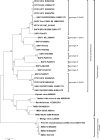Cardioviruses are genetically diverse and cause common enteric infections in South Asian children
- PMID: 19193786
- PMCID: PMC2668475
- DOI: 10.1128/JVI.02085-08
Cardioviruses are genetically diverse and cause common enteric infections in South Asian children
Abstract
Cardioviruses cause enteric infections in mice and rats which when disseminated have been associated with myocarditis, type 1 diabetes, encephalitis, and multiple sclerosis-like symptoms. Cardioviruses have also been detected at lower frequencies in other mammals. The Cardiovirus genus within the Picornaviridae family is currently made up of two viral species, Theilovirus and Encephalomyocarditis virus. Until recently, only a single strain of cardioviruses (Vilyuisk virus within the Theilovirus species) associated with a geographically restricted and prevalent encephalitis-like condition had been reported to occur in humans. A second theilovirus-related cardiovirus (Saffold virus [SAFV]) was reported in 2007 and subsequently found in respiratory secretions from children with respiratory problems and in stools of both healthy and diarrheic children. Using viral metagenomics, we identified RNA fragments related to SAFV in the stools of Pakistani and Afghani children with nonpolio acute flaccid paralysis (AFP). We sequenced three near-full-length genomes, showing the presence of divergent strains of SAFV and preliminary evidence of a distant recombination event between the ancestors of the Theiler-like viruses of rats and those of human SAFV. Further VP1 sequencing showed the presence of five new SAFV genotypes, doubling the reported genetic diversity of human and animal theiloviruses combined. Both AFP patients and healthy children in Pakistan were found to be excreting SAFV at high frequencies of 9 and 12%, respectively. Further studies are needed to examine the roles of these highly common and diverse SAFV genotypes in nonpolio AFP and other human diseases.
Figures





References
-
- Brahic, M., J. F. Bureau, and T. Michiels. 2005. The genetics of the persistent infection and demyelinating disease caused by Theiler's virus. Annu. Rev. Microbiol. 59279-298. - PubMed
-
- Casals, J. 1963. Immunological characterization of Vilyuisk human encephalomyelitis virus. Nature 200339-341. - PubMed
Publication types
MeSH terms
Substances
Grants and funding
LinkOut - more resources
Full Text Sources
Other Literature Sources

